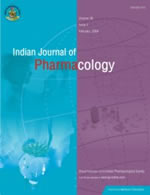
|
Indian Journal of Pharmacology
Medknow Publications on behalf of Indian Pharmacological Society
ISSN: 0253-7613 EISSN: 1998-3751
Vol. 43, Num. 2, 2011, pp. 224-224
|
Indian Journal of Pharmacology, Vol. 43, No. 2, March-April, 2011, pp. 224
Book Review
Research methodology simplified: Every clinician a researcher
Tejinder Singh
MA Distance Educ, PG Dip Higher Educ, Dip Training and Devp. Vice Principal; Professor of Pediatrics; Program Director, CMCL-FAIMER Regional Institute; Coordinator, Medical Council of India Nodal Center for Faculty Devp; Program in charge, PG Diploma in Mother and Child Health (IGNOU) International Fellow in Medical Education (2007) and (2009); FAIMER Fellow (2003); Swedish International Devp Agency Fellow (2002), Christian Medical College, Ludhiana - 141008, India
Correspondence Address: Tejinder Singh,
MA Distance Educ, PG Dip Higher Educ, Dip Training and Devp. Vice Principal;
Professor of Pediatrics; Program Director, CMCL-FAIMER Regional Institute;
Coordinator, Medical Council of India Nodal Center for Faculty Devp;
Program in charge, PG Diploma in Mother and Child Health (IGNOU) International
Fellow in Medical Education (2007) and (2009); FAIMER Fellow (2003);
Swedish International Devp Agency Fellow (2002), Christian Medical College,
Ludhiana - 141008,
India
Code Number: ph11064
Mahendra N. Parikh, Avijit Hazra, Joydev Mukherjee and Nithya Gogtay
Publishers: Jaypee Brothers Medical Publishers (P) Ltd., 1 st edn., 2010, ISBN 978-93-5025-003-7, pp 260 This handbook by Parikh, Hazra, Mukherjee, and Gogtay is a welcome addition to the literature on research methodology. There is no denying that research is a very important component of modern medicine and is one of the few elements which explain the progress of modern over traditional medicines. There have been ups and downs in promoting research and the recent emphasis on publications, as requirement for academic promotions is likely to give it a further boost. Unfortunately, not much attention is paid to research methodology during medical education both at UG and PG levels. Since many of the guides themselves hardly had any training in research methodology, mediocrity in research continues unabated. While not all research is aimed to win a Nobel Prize, a certain degree of methodological rigor is required. Ample evidence is accumulating to show that the research orientation of the faculty reflects in the quality of teaching. A clinician needs orientation in research---it could be in research methodology on one end and interpretation of research on the other. There are situations when young doctors are presented so-called research findings by medical representatives and get influenced into prescribing their brands. A critical analysis of methodology and research will arm every clinician to determine the true worth of all claims. The ultimate beneficiary of this effort will be the medicine′s forgotten man---the patient! Against this background, I see a potential use of this book to clarify the basic concepts related to research methodology. Spread over 25 chapters, it takes the readers through a wide spectrum of requirements for research, namely from planning the study to applying for funds, data management, and then its publication. There is a natural progression from the planning of research activity to its logical conclusion, i.e. publication. Chapters related to statistical analysis are elaborate and clarify the concepts to a large extent. A good number of solved examples have been provided to help the readers understand some common issues like calculation of sample size or understanding the significance of difference. It may not enable the readers to perform many of the analyses themselves but it will surely help them to understand and interpret what various values mean. Chapters related to publication of scientific material are especially useful. The part devoted to clinical trials will also be useful for many in academic as well as non-academic institutions. A chapter on postgraduate thesis will be useful for students across all disciplines. Similarly, chapter on evidence based medicine is also informative and will help in making better clinical decisions. Faculty members as well as students should find the book useful from this perspective. At some places, the text has become too dense. For new readers, it may be little taxing and could have been made simpler by adding more examples. However, overall, the book can be recommended as a useful addition to the institutional and departmental libraries.
Copyright 2011 - Indian Journal of Pharmacology
|
